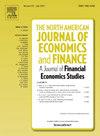Volatility spillovers in forex markets and the role of quantitative easing
IF 3.9
3区 经济学
Q1 BUSINESS, FINANCE
North American Journal of Economics and Finance
Pub Date : 2025-07-30
DOI:10.1016/j.najef.2025.102515
引用次数: 0
Abstract
This research aims to investigate the volatility spillover relationship among 20 major currencies, using a dataset of 5-minute exchange rates over the 2012–2023 period. Its contribution is based on the combination of both asymmetric and time–frequency aspects while including a regression analysis to examine the impact of the COVID-19 pandemic and quantitative easing on this volatility spillover. The empirical results show a high degree of volatility spillovers in the foreign exchange market, especially for currencies in the same geographical area. These volatility spillovers were highest during the first wave of the COVID-19 pandemic in early 2020, much higher than at the start of the Ukraine-Russia war in early 2022. Significantly, the COVID-19 pandemic only affects negative volatility spillovers. In addition, quantitative easing is an important determinant of volatility spillovers in the foreign exchange market. However, its effect on volatility spillovers differs across time horizons, being negative in the short run and positive in the long run. This finding implies that policymakers should consider the long-term effects of quantitative easing when designing such a policy and when using it as a short-term solution in times of crisis.
外汇市场波动溢出效应与量化宽松的作用
本研究旨在利用2012-2023年期间的5分钟汇率数据集,探讨20种主要货币之间的波动溢出关系。其贡献是基于非对称和时频两方面的结合,同时包括回归分析,以审查COVID-19大流行和量化宽松对这种波动性溢出的影响。实证结果表明,外汇市场存在高度的波动溢出效应,特别是对于同一地理区域内的货币。这些波动性溢出效应在2020年初的第一波COVID-19大流行期间最高,远高于2022年初乌克兰-俄罗斯战争开始时的水平。值得注意的是,2019冠状病毒病大流行只会影响负面的波动性溢出效应。此外,量化宽松是外汇市场波动溢出效应的重要决定因素。然而,它对波动性溢出的影响在不同的时间范围内是不同的,短期是负面的,长期是积极的。这一发现意味着,政策制定者在设计量化宽松政策时,以及在危机时期将其作为短期解决方案时,应该考虑量化宽松的长期影响。
本文章由计算机程序翻译,如有差异,请以英文原文为准。
求助全文
约1分钟内获得全文
求助全文
来源期刊
CiteScore
7.30
自引率
8.30%
发文量
168
期刊介绍:
The focus of the North-American Journal of Economics and Finance is on the economics of integration of goods, services, financial markets, at both regional and global levels with the role of economic policy in that process playing an important role. Both theoretical and empirical papers are welcome. Empirical and policy-related papers that rely on data and the experiences of countries outside North America are also welcome. Papers should offer concrete lessons about the ongoing process of globalization, or policy implications about how governments, domestic or international institutions, can improve the coordination of their activities. Empirical analysis should be capable of replication. Authors of accepted papers will be encouraged to supply data and computer programs.

 求助内容:
求助内容: 应助结果提醒方式:
应助结果提醒方式:


